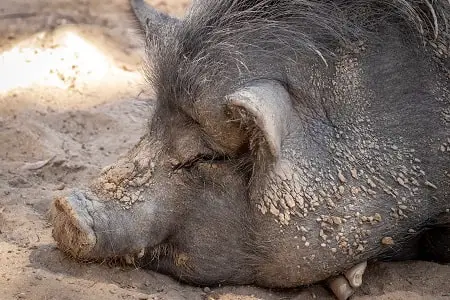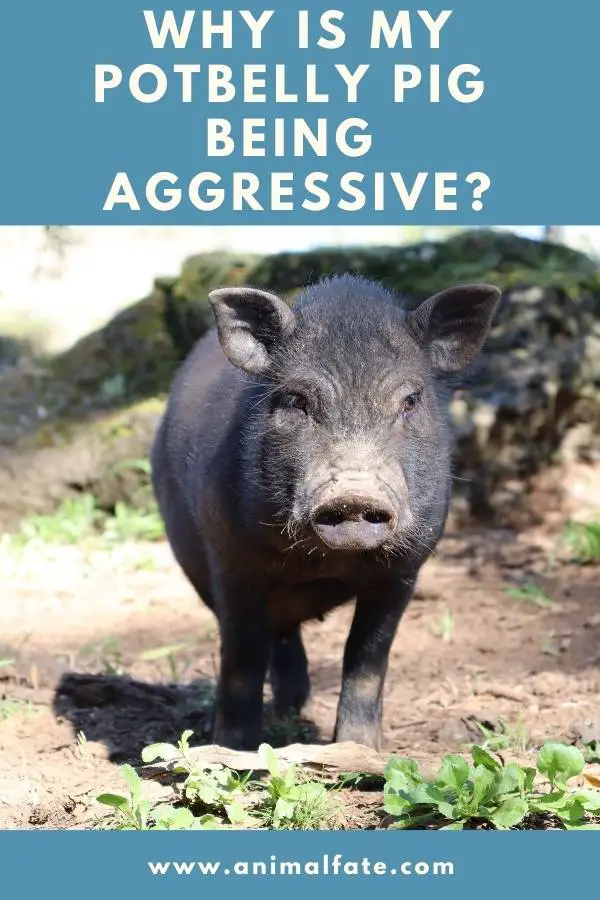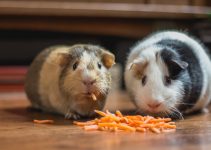Potbellied pigs usually start to be aggressive due to inappropriate behavior by their owners. People think having a potbelly pig is easy, but it requires raising and understanding an animal. Potbelly pigs might also be aggressive because they protect territory or challenge humans for dominance once they’re adults.
Potbelly pigs might be fascinating pets, but they are still animals. For this reason, you may want to be aware of proper responses and how you should treat them.
Let’s get into it more!
Contents
Are potbelly pigs aggressive to humans?
Potbelly pigs are aggressive by nature. However, they are herd animals that have a firm pecking order.
By pecking order, it means these animals have a hierarchy of status among the members.
For this reason, they can be quite territorial, mostly if they get spoiled by their owners.
Further, since they are herd animals, they can be aggressive to unfamiliar people.
Thus, they are likely aggressive to guests and even family members they saw for the first time.
Potbelly pigs can be adorable and sweet pets. Still, it would be best not to spoil it, and let it do whatever it wants.
Once these animals get spoiled, they even tend to be aggressive to you, as if trying to challenge. It’s also like they are trying to take dominance in the area.
As owners, you should train your pet and show dominance starting from an early age.
At the same time, please don’t spoil it and let it have what it wants. A little discipline goes a long way, significantly as these animals grow.
You May Also Read – How to make a show pig gain weight fast?
How can you tell if a pig is aggressive?
Pigs that get aggressive can be quite noticeable. With some gestures and noises, you can quickly tell yourself to be careful with it.
First, aggressive pigs have the following gestures:
Sideways body posture
An aggressive swine faces you sideways, not directly.
Hackles up
The hairs in their skin start to turn up as these animals get aggressive.
Chomping mouth
Hogs and all other types of swine chomp their mouth when they feel angry or aggressive.
High-pitched tones
They make high-pitched tones not only when they feel threatened, but also when they’re mad.
These are the early stages of aggression. If it worsens, that’s when the biting incidents may happen.
If you own a potbelly pig, chances are it’ll make these gestures when some guests are around.
You May Also Read – What does it mean when a pig wags its tail?
How to avoid aggressive behavior from your pig?

The aggressive attitude of pigs comes from their territorial instinct. Thus, while you can’t directly prevent it, you can do some things to avoid and control it.
Start when they’re young
It’s essential to train these animals when they’re still young.
Although it’s quite tempting to spoil them, it would be best to apply discipline at your pet’s early age.
Spoiling them will only make them aggressive as they grow.
Separate the resources
Potbelly pigs are herd animals, and they can be quite competitive in sharing.
Thus, if you have other pets and even just a pair of pigs, it would be best to separate their feed and even their places.
With this, you’ll avoid these animals fighting over something.
Provide a large space
Having a large space that your pet can call it’s own would be best to avoid its aggressiveness.
You can make an enclosed yard where your pet is the only one around. That way, you can avoid any aggressive incidents, especially inside your place.
Did your pig nudge you? What does it mean? Read more here.
What to do if a pig bites you?
If your pig bites you, it is usually due to one of these three reasons:
- Fear (it usually happens in piglets)
- Aggression (which occurs due to their instinct)
- Dominance (which occurs when they feel like wanting to show power)
Whatever the reason, it can be quite bothersome to have a swine bite you.
Here are some things you can do if a pig bites you:
Ignore your pig
Put it back in its area and ignore it. Ignoring is an effective method to discipline your pet.
Use positive reinforcement
Positive reinforcement means you give some rewards for the good things your pet does.
Giving treats to your pet when they do good makes them continue doing it. Moreover, it makes them avoid doing bad things, including biting.
Introduce new toys
Introducing new toys will make their attention focus on it and not on you and other people.
Supervise its interactions
If your pet is playing with another animal, or with your kids, always watch to prevent any biting incident.
Try some crate training
Crate training is as useful to pigs as it is to dogs and other pets. Doing so would train your pig to avoid these incidents and behave well at all times.
Do you want to stop pig from squealing? Learn how.
How to discipline your potbelly pig?
Potbelly pigs can be sweet, but they can also be aggressive when they feel like being territorial.
For this reason, it would be best to start training them when they are still young.
As I said earlier, it’s important to discipline your potbelly pig, especially at an early age.
The reason is that once they become adults, and they grow up spoiled, they tend to do things their way.
If you want to discipline your potbelly pig for biting or doing a bad thing, ignoring it would be your best bet.
Avoid touching it and giving it treats. At the same time, talk silently and appreciate if your pet shows affection again.
If it displays terrible behavior again, repeat the process and leave it alone.
It may be quite repetitive, so starting it at a young age is the best thing to train your pig.
After some time of training, your pet will eventually learn how to behave well.
Summary
Indeed, potbelly pigs are quite fascinating and sweet pets. Still, when instincts kick in, they can be territorial and aggressive.
If your pet is being aggressive, don’t take it personally. Pigs are animals, and they act on instinct. What you can do is to respond appropriately and discipline it to avoid such behavior from happening again.
Resources
Image credits – Photos by Sofia Borrego and Grant Durr on Unsplash



